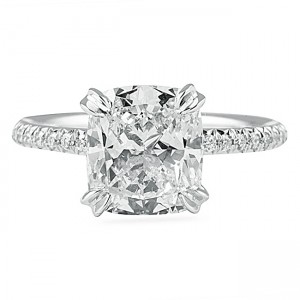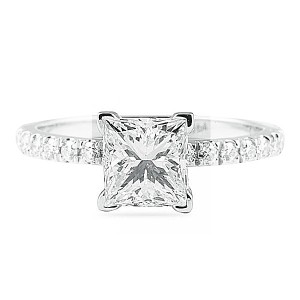These days, there are many more options in the fine details of engagement rings than there used to be. The most important, but sometimes overlooked part of the ring, the prongs, have a number of different styles. While a necessity for obvious reasons, most people tend to overlook them and in most cases aim to diminish their appearance as much as possible as to keep the main focus on the center diamond and not the metal that is holding it in place.
In any ring, prongs are the tiny metal hooks that grab the edges of a stone and hold it in place. They can be different shapes, sizes, and different amounts. Each individual prong can be button shaped, clawed, split or “V” shaped. The setter applies pressure at each of these points to securely hold the center-diamond in place.
 Claw prongs (as shown on the left in our RS-101 rose gold ring) are when the prongs taper off as they reach the stone to a fine point. This style is commonly used because it takes up the least amount of space on the stones surface so they can often appear to not be there. Button prongs are the original standard and are straight and rounded on the end. Claw prongs work best on round, oval, radiant and emerald cut diamonds.
Claw prongs (as shown on the left in our RS-101 rose gold ring) are when the prongs taper off as they reach the stone to a fine point. This style is commonly used because it takes up the least amount of space on the stones surface so they can often appear to not be there. Button prongs are the original standard and are straight and rounded on the end. Claw prongs work best on round, oval, radiant and emerald cut diamonds.
 Both of these standard shapes can come in a split prong (see our engagement ring model# VNR-13143 on the right), where the one prong splits into two once it reaches the stone, giving the illusion of double prongs. This style takes up a little more space on the stone, but can add an illusion of different shape, as well as a more intricate detail. They also function to add more security and can often be used on cushion cut center diamonds which require stronger prongs than most other shapes.
Both of these standard shapes can come in a split prong (see our engagement ring model# VNR-13143 on the right), where the one prong splits into two once it reaches the stone, giving the illusion of double prongs. This style takes up a little more space on the stone, but can add an illusion of different shape, as well as a more intricate detail. They also function to add more security and can often be used on cushion cut center diamonds which require stronger prongs than most other shapes.
In any case, you don’t ever want prongs that are too small for the stone or you can greatly risk losing a prong, even worse, the diamond. The other common variation you will see is four, six, or eight prongs. You normally see eight prongs when you have double prongs that are bunched together to look like four. The thing people usually worry about when choosing between four and six is security, which does tend to depend on which type of metal is being used. Four prongs can be just as strong as six. Four is a great option and the more common of the two because it usually allows you to see more of the diamond, so as long as they are sturdy enough, less is more! However, for a marquise or pear shape diamond you will need at least five or six prongs to keep these elongated diamonds in place.
 The last style of prong is the “V-prong” (see model# SOR-13299 to the left) which is used to protect the points of sharp cornered diamonds namely princess cuts, pear shapes and marquise cuts. While not as delicate or visually appealing as the previously discussed prong styles, they are necessary to ensure that the fragile points of these diamonds remain in tact and completely protected.
The last style of prong is the “V-prong” (see model# SOR-13299 to the left) which is used to protect the points of sharp cornered diamonds namely princess cuts, pear shapes and marquise cuts. While not as delicate or visually appealing as the previously discussed prong styles, they are necessary to ensure that the fragile points of these diamonds remain in tact and completely protected.
There are many details to designing a ring and we here at Lauren B are great at guiding you through each and every one to create the most perfect ring.
